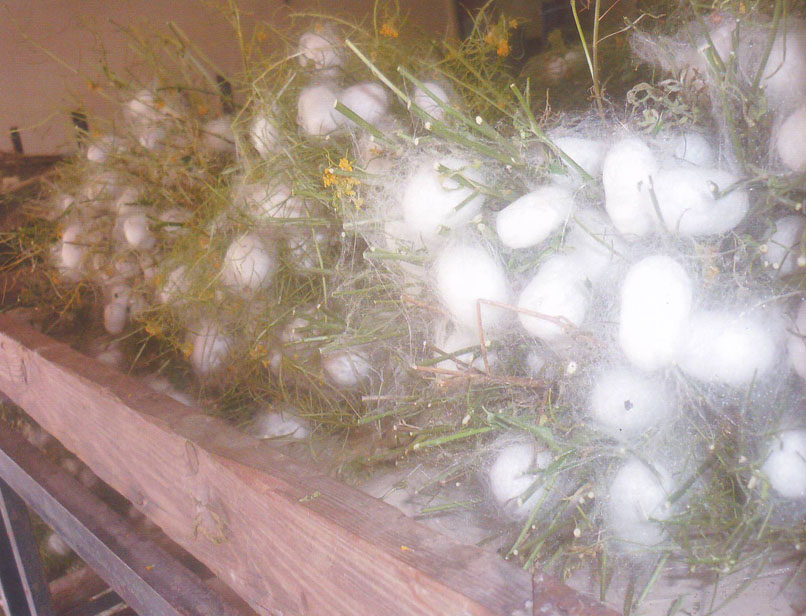Uzbekistan, a leading producer of silk cocoons, relies on forced labor for their production, which violates the rights of farmers and public-sector workers and exploits the vulnerability of the rural poor. Uzbek farmers must produce silk cocoons under coercion to fulfill government quotas and they must sell their cocoons to the government at the official procurement price, leaving them little or no profit, and in many cases in debt.
Uzbekistan ranks first in the world for the production of cocoons of silkworm per capita. According to official data, in 2015-2016 the production of cocoons in Uzbekistan exceeded 26,000 tons.
In 2015, UGF conducted monitoring of labor rights in the silk sector in Uzbekistan. The report “Silk Loop for Uzbek Farmers” gives insight into Uzbek silk production and the wide use of forced labor in this industry.
UGF monitors spoke with dozens of farmers in May and June this year and found that the forced labor situation has largely remained unchanged. Here we present an interview conducted with a farmer from the Jizzakh region in June 2018:
– Tell me, how did you grow silk cocoons this year?
I have 72 hectares of irrigated fields: 40 hectares are for wheat and 32 hectares for cotton. Cacoons quotas come from above. From Tashkent to the region, from the region to the district, from the district to the SFU (Suvdan Foydalanuvchilar Uyushmasi), i.e. the Unin of Water Users. They are former sovkhozes [trans. – state farms]. There are units in sovkhozes, and there are farmers in the SFU. A district hokimiyat allocates a cotton quota to every SFU based in the total area of farms included in the SFU. Then, this general quota is divided up among farmers. According to their calculations, I have to submit 2.2 kilos of cocoons per hectare, so as I have 72 hectares of irrigated fields, my quota is 158.4 kilos of cocoons.
In previous years, we could just make an estimated quota on paper, give a certain amount of money as a bribe to someone, and meet the quota that way. This year, they say the procedure is different. This year, they speak of “CLUSTERS”, i.e. the producers, i.e. the farmers, themselves, those very people who process these cocoons into threads and then into the fabric, and then into clothes, are now the customers. Therefore, a cluster system stipulates that a certain product will be manufactured from silk cocoons. It is impossible to come to the same terms with them [trans. – producers]. They [trans. – producers] need actual cocoons. They would never give farmers any kind of receipt for cocoons received for any amount of money.
But … not all farmers are able to meet their quota, so they have to buy cocoons. They cost 40,000 soum per kilo. Yesterday morning the head of our sovkhoz (SFU) said that he would get cocoons at a lower price: 27,000-28,000 soum per kilo. Those who give money will meet their quota. It is not overstated figures. They [trans. – farmers who can afford to buy cocoons] buy and submit the actual product. There are people who grow cocoons on their own. They have no quota. Their families, i.e. their parents have been growing cocoons since Soviet times. Since then, they have specialized in it. They have built entire livestock sheds on their land. Currently, these sheds have been turned into places where they grow caterpillars, which make cocoons. And they sell their cocoons to farmers. They grow tons of them. That is why many farmers do not grow cocoons themselves but hope to be able to buy cocoons from such people.
– To which enterprise have you submitted cocoons?
So far there is no information on the price. But they say that it would be much higher than the previous year. So far everything stays the same. We were given two bags of flour each from a silo and 10 liters of oil from the factory. That’s it so far. Last year we were paid 5,000 soum per kilo. Even if this year they double the price to 10,000 soum, it will not pay off the expenses for cocoons which we buy for 27,000-40,000 soum.
And cocoons are received by representatives of CLUSTERS. The district office for cocoons is absent this year.
– Is growing cocoons one of your duties? Do you do it voluntarily?
I would be glad to refuse to grow cocoons. But how? Since the beginning of times, since Soviet times, quotas for cocoons were given to sovkhoz units. It was inherited by current farmers. How can we refuse? I have not seen a farmer refuse to grow cocoons. Many farmers buy caterpillars and then throw them away. When the time to submit cocoons comes, they make something up. They try to submit nothing. If it is demanded, they buy cocoons from other people and submit a part of the harvest. If the hokim or district prosecutor is informed, they submit some cocoons again. If a farmer is well enough off, he will buy and submit everything to meet the quota in order to be left alone. If a farmer is poor, then he will not meet the quota no matter what. The hokim and prosecutor are responsible for meeting quotas on grain and cotton. If quotas on cotton and grain are met, then, as an exception, a farmer would stay “alive”. However, if both quotas are not met, those farms are closed.
– What would happen if you refused?
There are a lot of examples of farmers who were not able to meet a quota on cocoons and were driven to despair. It is not a joke. The district hokimiyat must meet quotas on cocoons. Thehokim, prosecutor, and the head of the district police are responsible for that. They are held accountable by their superiors. In turn, they hold farmers accountable. That is why they require every farmer to meet the quota. If a farmer does not meet the quota for cocoons, he has to face the consequences. There is no mercy! It is better to do what is required in order to prevent shutting down a farm.
– Please explain why you grow cocoons.
We are required to do so and we do it. When we got a farm, we saw that everybody does it, and no one thinks of refusing. So, we also went and signed an agreement with cocoon growers, registered it, obtained caterpillars, and now, after signing the agreement there is no way out. We are obliged to grow them.
– How much could you earn?
What are you talking about? If they take158.4 kilos and pay even10,000 soum, then we have 1,584,000soum.
And the expenses are twice this sum. You need to do the math!
For the whole month, I have to provide caterpillars with food, i.e. mulberry leaves. It has to be done continuously because if you are late with feeding them, caterpillars will die.
- A)I drive through the districts looking for mulberry trees. I have an old“Zhiguli” [trans. – type of car manufactured in Russia and the Soviet Union]. Every day I need 10 liters of gasoline, which costs 5,000 soum on average. So, calculate: 10 liters ×5,000 soum = 50,000 soum× 30 days = 1,500,000 soum.
- B)30 working days for one of my workers to cut mulberry branches. I paid him 30,000 soum × 30 days = 900,000 soum.
- C)I have been driving rocky, very dangerous roads for 30 days. Because of that, I had to repair my car three times. It cost me 1,000,000 soum in total.
- D)During the whole month, my wife, my mother, and my two sisters fed the caterpillars at home. I had to give them something as well. I gave them two bags of flour and 10 liters of cotton oil. Also, they [trans. – women in the interviewee’s family] wait for [trans. – silk]every year. Usually, every year, based on the number of cocoons submitted the District Office for Cocoon Growing gave silk material as a payment. And silk is very special for women. It is considered a payment for cocoAnd the revenue from the cocoons submitted would be 158 kilos× 10,000 soum = 1,580,000 soum.
- E)On the day of collecting the cocoons, my eldest daughter invited her classmates to come and help us. I organized a good lunch for them for 200,000 soum. Plus, I promised to host a picnic to celebrate graduation from the ninth grade. It cost me 200,000 soum. All in all, it is 400,000 soum.
- F)Also, there are a lot of other expenses, in total about 500,000 soum.
Therefore, I spent about 6 million soum to grow cocoons and was paid only 1,580,000soum.
– When do you receive payment for cocoons?
When we received the caterpillars, we were given two bags of flour and 10 liters of cotton oil. Now, after submitting the cocoons, they will give us finished silk materials instead of payment. They deduct all expenses and profit and give something negligible. But the biggest insult is that cocoon growers have to calculate all their expenses for growing caterpillars as their own, such as feeding the caterpillars and collecting mulberry branches. If anyone tries to argue at the meeting, the hokim stands up and asks: “Who is dissatisfied? Prosecutor, check what he [trans. – farmer] has planted. How much area is unlawfully used to grow vegetables?!…” You immediately shut your mouth. That is why we keep our mouths shut.
– How long does it take you to grow cocoons?
One month. From beginning to end, if you take care of caterpillars, it takes one month. At the beginning of the month, we receive caterpillars and submit cocoons after 30 days. Usually, it happens in May. Sometimes it starts in the middle of April.
– How many people at your farm have been involved in growing cocoons?
All of us: me and three workers responsible for irrigation. I also hired one person for the whole month. Everybody at home was also working: my mother, my wife, and two sisters.
– Have government organizations’ employees or students been involved in this work?
My daughter’s classmates participated during the last day of collecting cocoons. They worked from morning till 4 o’clock in the afternoon. The rest of the time was spent collecting cocoons ourselves.
– Were they sent by the hokimiyat?
No, they were not. My daughter invited them.
– And what is the role of the hokimiyat?
First, they made me sign the contract with the cocoon growing company. Then, they made me buy caterpillars in accordance with the agreement made. And for the whole month they monitored the work and reminded me every time what would happen to me if I did not meet the quota for the cocoons.
– What facility have you been using for growing cocoons?
My own livestock shed. I just adapted it.
– What else can you add about cocoons?
Cocoons are a drain. It is a costly affair, which is impossible to refuse. That is why they make farmers do it.





